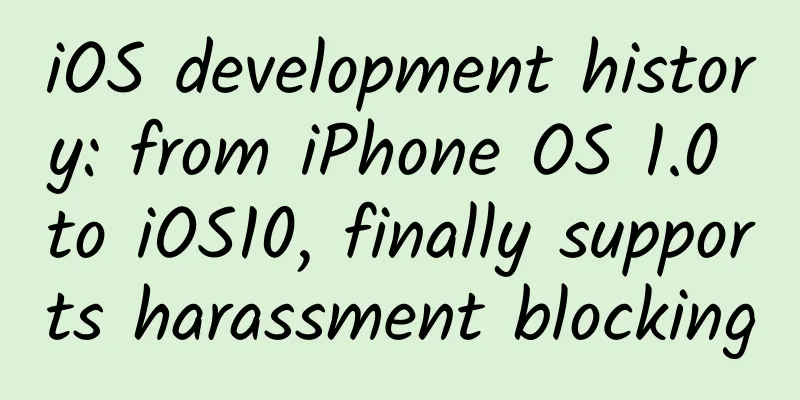iOS development history: from iPhone OS 1.0 to iOS10, finally supports harassment blocking

|
At the early morning of September 8th, Beijing time, Apple officially released iOS 10 at its autumn conference. From 2007, when iPhone OS 1.0 appeared, to now, Apple's system has gone through 10 generations of changes. Guided by meeting user needs, Apple's system has gradually innovated and become smarter, using technology to provide users with the most perfect mobile phone experience. iPhone OS 1.0: The first multi-touch system is released In September 2007, Apple's first operating system, OS 1.0, was released, which had features such as virtual voicemail, mobile web browsing, and watching YouTube videos. In addition, iPhone OS 1.0 supported multi-touch gestures, bringing people a stylus-free, button-free, and multi-touch mobile phone operation experience for the first time. Later, iOS 1 also added support for customizable home screens, and iPod Touch users also had new applications: Mail, Maps, Weather, Notes, and Stocks.
iPhone OS 2.0: Chinese handwriting input "pleases" Chinese users The second-generation iPhone OS operating system was released in July 2008 along with the iPhone 3G, which supports Chinese handwriting input. The iPhone 3G was also the first iPhone to be introduced in the Chinese market, adding AppStore, GPS navigation and email push functions. The AppStore brought by the new version of the operating system supports users to download third-party application software, and also adds functions such as global search and scientific calculator. Users can solve some more complex problems through the system. iPhone OS 3.0: Copy and paste function "frees" your hands iPhone OS 3.0 was released in June 2009, adding more than 100 features. The system added many new features based on the previous two generations: voice control, multimedia messaging, Spotlight search, horizontal keyboard, optimized compass, Spotlight global search and voice memo. It is worth mentioning that the added cut, copy and paste functions greatly reduced the burden of manual input for users. iOS 4: Smarter multitasking, support for CDMA networks, more popular in China Since the release of iPhone 4 in June 2010, the iPhone OS system has been officially renamed to the familiar "iOS". The biggest feature of iOS 4 system is that it supports CDMA network (China Telecom 2G network). As a result, iPhone quickly appeared in the streets and alleys across the country, becoming the most expensive "street machine" at the same time. Another selling point of iOS 4 is that it supports multi-tasking, which makes chatting and browsing the web harmoniously integrated. At the same time, iOS 4.0 is the operating system with the biggest appearance improvement among the previous four generations of iOS systems. The icons on the interface are designed with complex light and shadow effects, making the interface look more beautiful, and users can change custom wallpapers. iOS 5: Teasing Siri Begins Here In iOS 5.0, simulated skeuomorphic design has reached its peak. A large number of textures that imitate real-world objects appear in the iPhone's software interface, such as the "Memo" application with a yellow paper background and the "Reminder" application with a linen texture. iCloud cloud service is one of the biggest selling points of iOS5. Users can use iCloud to back up all kinds of data on their devices, and use this function to find the approximate location of their iOS devices and friends. In addition, the pre-installed software of iOS5 adds Twitter social network, and the intelligent person Siri is online. iOS 6: New Do Not Disturb mode to combat harassing calls iOS6 operating system has built-in Apple's own map service, turn-by-turn navigation function, navigation service that gives voice reminders when the vehicle needs to turn, integration with Facebook and Passbook, and support for LTE network. At the same time, iOS 6 adds Do Not Disturb mode, so you no longer have to worry about being woken up by harassing calls when you sleep; it also brings Passbook, the predecessor of Apple Maps and Wallet, and for the first time brings 360-degree panoramic shooting function. Among them, support for Passbook is a very convenient function. Your boarding pass, movie tickets, shopping coupons, membership cards and more tickets are now organized in Passbook. iOS 7: Flat design and fingerprint recognition, leading the trend iOS 7 was released under Jonathan's leadership, and the entire iOS system was redesigned. All the skeuomorphic icons were flattened, simple, flat and light, greatly reducing the visual pressure on users. The system not only adopted new application icons, but also redesigned built-in applications, interfaces and notification centers, and optimized the photo application. With the help of iOS 7 and the iPhone 5s launched at the same time, the fingerprint recognition function was gradually accepted by users, and the industry paid more attention to it and tried to apply it. iOS 8: Open exploration of a closed system iOS 8, released in September 2014, did not have much change in its interface appearance. iOS 8 opened up as many as 4,000 API interfaces, and the Touch ID and camera APIs were officially opened to third parties. This was also a "flexible breakthrough" for Apple while maintaining the closed nature of the system. iOS8, along with the iPhone 6 and iPad Air 2, added Apple Pay, Health, HandOff, QuickType, Family Sharing, iCloud Drive, third-party keyboard support, and Apple Music. The built-in camera also added time-lapse photography mode and time-lapse photo mode. The photo function added "smart editing", such as smart adjustment and filters. iOS8 supports voice activation of Siri, and "Hey, Siri" starts the Siri virtual assistant. iOS 9: "Ping Fang" font designed specifically for China iOS9 focuses on improving the functionality of the system, such as making Siri and search smarter, adding public transportation information, split-screen operation, and starting to support third-party input methods. In this system, the Chinese system font has been changed to "Ping Fang" designed specifically for China, and a power saving function has been added for the first time, which has relatively increased battery life, which is a very good improvement for many people who are addicted to their phones. The new features of iOS9 will include: the new upgraded Note (supports stick figures and pictures to add), the newly upgraded Apple Maps (new public transportation function), the News application (replaces Newsstand, displays news content from media such as CNN and Wired), Passbook is renamed Wallet, adds support for membership cards and gift cards, split-screen multi-window function (SlideOver, SplitView and picture-in-picture function), power saving mode, 6-digit password, improved battery life, etc.
iOS 10: Open caller ID interface to end phone harassment and fraud The iOS 10 system officially released by Apple has opened multiple API interfaces, including the opening of native application APIs such as Siri and iMessage, making users' lives more convenient. For example, users can use Siri to call a taxi, order food, and send WeChat messages through voice commands, starting a smart life. In addition, iOS10 has been optimized specifically for Chinese iPhone users, adding a harassment call identification function, with technical support provided by Tencent Mobile Manager. After the official iOS version was launched on September 14, Apple users upgraded their systems to iOS10 and then installed or upgraded the latest version of Tencent Mobile Manager. When the phone receives a harassment or fraud call, the page will display "Tencent Mobile Manager identification words" to remind people to answer the call with caution, completely ending the years-long problem of harassment and fraud calls for iPhone users.
From iPhone OS 1.0 to iOS10, Apple's system has always insisted on ease of use and humanization. I hope the next upgrade will bring more surprises to users. |
<<: A more reliable method for detecting horizontal and vertical screens on mobile devices
>>: How to debug CSS compatibility issues in iPhone Safari browser
Recommend
Cocos 2d-JS Chinese version API documentation is officially launched
Open source engines are naturally sharing-minded....
What are the three enemies that cockroaches fear the most? How to prevent cockroaches from crawling onto your bed at night? Introducing the four most effective methods of radical cure!
Whenever the weather gets warm, cockroaches will a...
Tongjiang SEO training: How to embed SEO optimization thinking into the website
The purpose of building a website is to showcase ...
From imitation to surpassing the original, 10 key factors of APP "plagiarism"
Imitation is the best way for many teams to get s...
A collection of 27 early films by Ge You before 2002
Ge You became famous for his comedies and establi...
The correct approach to algorithm analysis
[This series of blog posts will analyze and summa...
Why did quantum dots, which can solve the weakness of LCD picture quality, wait until this year to appear?
A new term for LCD TVs has entered the vision of ...
[That Day] 13 years ago today, China's third Antarctic scientific research station, Kunlun Station, was completed
On January 27, 2009, China's third Antarctic ...
This delicious food is now on the market in large quantities, but don't eat it when it turns red!
Review expert: Wang Xuejiang, professor at Capita...
What scope is Wenchang Tower applicable to?
1. For families with school-age children, placing...
15 sales secrets to achieve 100% conversion rate, how to ask questions to dig deep into needs
15 Sales Secrets for 100% Conversion Rate Resourc...
My bones are always making crackling sounds. Do I need treatment?
Audit expert: Wang Linyu Deputy Chief Physician, ...
A brief discussion on APP operation and promotion: How to place advertisements accurately?
Preface: As of the end of March this year, accord...
She is a true "light chaser", making the magic of the sun shine brightly in life
There has never been a lack of great women on the...
Google, BlackBerry team up to make Android devices more secure
BlackBerry has announced a partnership with Googl...









